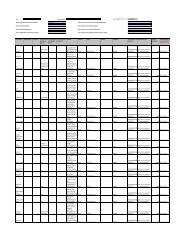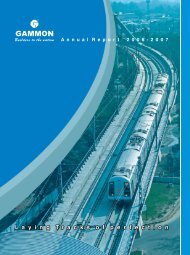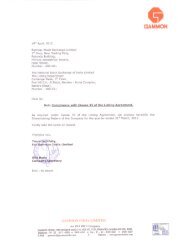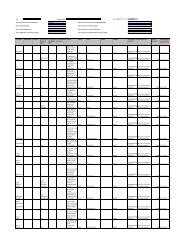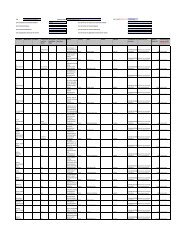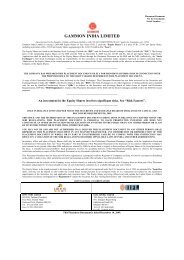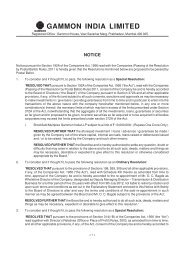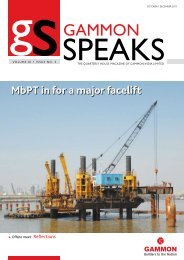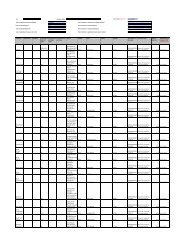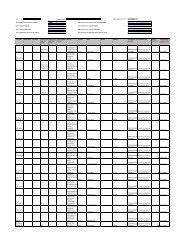Annual Report 2010-2011 - Gammon India
Annual Report 2010-2011 - Gammon India
Annual Report 2010-2011 - Gammon India
You also want an ePaper? Increase the reach of your titles
YUMPU automatically turns print PDFs into web optimized ePapers that Google loves.
128<br />
14. Employee Stock Option Scheme<br />
Employee stock options are evaluated and accounted on intrinsic value method as per the accounting treatment prescribed under Guidance<br />
Note on "Accounting for Employee Share-based payments" issued by the ICAI read with SEBI (Employee Stock Option Scheme & Employee Stock<br />
Purchase Scheme) Guidelines, 1999 issued by Securities and Exchange Board of <strong>India</strong>. Accordingly the excess of market value of the stock options<br />
as on the date of grant over the exercise price of the options is recognized as deferred employee compensation and is charged to profit and loss<br />
account on graded vesting basis over the vesting period of the options. The un-amortized portion of the deferred employee compensation is<br />
reduced from Employee Stock Option outstanding which is shown under Reserves and Surplus.<br />
15. Taxation<br />
Tax expenses comprise Current Tax & Deferred Tax.<br />
Current Tax is calculated after considering benefits admissible under Income tax Act, 1961. Deferred Tax is recognized on timing differences being<br />
the differences between the taxable incomes and accounting income that originate in one period and are capable of reversal in one or more<br />
subsequent periods. Deferred Tax Assets, subject to the consideration of prudence are recognized and carried forward only to the extent that<br />
there is a reasonable certainty that sufficient future taxable income will be available against which such Deferred Tax Assets can be realized. The<br />
tax effect is calculated on the accumulated timing difference at the year-end based on the tax rates and laws enacted or substantially enacted<br />
on balance sheet date.<br />
In situations where the Company has unabsorbed depreciation or carry forward tax losses, all deferred tax assets are recognised only if there is<br />
virtual certainty supported by convincing evidence that they can be realised against future taxable profits.<br />
Few Subsidiaries are eligible for 100% tax holiday under section 80-IA of the Income Tax Act, 1961. As a result, timing differences arising and<br />
reversing during the tax holiday period are not recognized by the Company.<br />
Minimum Alternative Tax (‘MAT’) credit is recognised as an asset only when and to the extent there is convincing evidence that the Company<br />
will pay normal income tax during the specified period. In the year in which the MAT credit becomes eligible to be recognized as an asset in<br />
accordance with the recommendations contained in Guidance Note issued by the Institute of Chartered Accountants of <strong>India</strong>, the said asset is<br />
created by way of a credit to the profit and loss account and shown as MAT Credit Entitlement. The Company reviews the same at each balance<br />
sheet date and writes down the carrying amount of MAT Credit Entitlement to the extent there is no longer convincing evidence to the effect<br />
that Company will pay normal Income Tax during the specified period.<br />
At each balance sheet date the Company re-assesses un-recognised deferred tax assets. It recognises the unrecognized deferred tax assets to<br />
the extent that it has become reasonably certain or virtually certain, as the case may be, that sufficient future taxable income will be available<br />
against which such deferred tax assets can be realised.<br />
In case of overseas subsidiaries and joint ventures, current taxes are calculated on the basis of the taxable income for the year, applying the tax<br />
rate in force, in those countries, as of the balance sheet date.<br />
16. Provisions, Contingent Liabilities and Contingent Assets<br />
Provisions involving substantial degree of estimation in measurement are recognised when an enterprise has a present obligation as a result<br />
of past event; it is probable that an outflow of resources will be required to settle the obligation, in respect of which a reliable estimate can<br />
be made. Provisions are not discounted to its present value and are determined based on best estimate required to settle the obligation at the<br />
balance sheet date. These are reviewed at each balance sheet date and adjusted to reflect the current best estimates. Provisions for risks and<br />
charges are recognized for losses and liabilities whose existence is certain or probable but the timing or amount of the obligation is uncertain as<br />
of the financial year end date.<br />
Contingent Liabilities are not recognized but are disclosed in the notes to accounts. Disputed demands in respect of Central Excise, Customs,<br />
Income tax and Sales Tax are disclosed as Contingent Liabilities. Payment in respect of such demands, if any, is shown as advance, till the final<br />
outcome of the matter.<br />
Contingent Assets are neither recognized nor disclosed in the financial statements.<br />
17. Earnings per share<br />
Basic and diluted earning per share is calculated by dividing the net profit or loss for the period attributable to equity shareholders by the<br />
weighted average number of equity shares outstanding during the period. The weighted average number of equity shares outstanding during the<br />
period is adjusted for events of share split.<br />
For the purpose of calculating diluted earning per share, the net profit or loss for the period attributable to equity shareholders and weighted<br />
average number of equity shares outstanding during the period is adjusted for the effects of all dilutive potential equity shares.<br />
18. Operating Lease<br />
Lease where the lessor effectively retains substantially all the risks and benefits of ownership of the leased term are classified as operating lease.<br />
Operating lease payments are recognized as an expense in the Profit and Loss Account on a straight line basis over the lease term.<br />
19. Derivatives<br />
Asof the date the contract is entered into, the derivative instruments are recorded at fair value and, if the derivative instruments do not qualify<br />
for being recorded as hedging instruments, the changes in the fair value recorded after initial statement as handled as components of the<br />
operating result for the year if they relate to forward transactions (sales or purchases) and the financial result for the year if relating to interest<br />
rate swaps. If instead the derivative instruments satisfy the requirements for being classified as hedging instruments, the subsequent changes<br />
in the fair value are recorded following the specific criteria indicated below. With regard to each financial derivative qualified for recording as a<br />
hedging instrument, its relationship with the hedged item is documented, along with the risk management objectives, the hedging strategy and<br />
the methods for checking the effectiveness. The effectiveness of each hedge is checked both at the time of initiating each derivative instrument,<br />
and over its duration. As a rule, a hedge is considered highly effective if, both at the start and over its duration, the changes in the fair value in<br />
the event of a fair value hedge or in the cash flows expected in the future in the event of a cash flow hedge of the hedged element, are essentially<br />
offset by the changes in the fair value of the cash flows of the hedging instrument.<br />
A NNUAL R EPORT I <strong>2010</strong>/11





